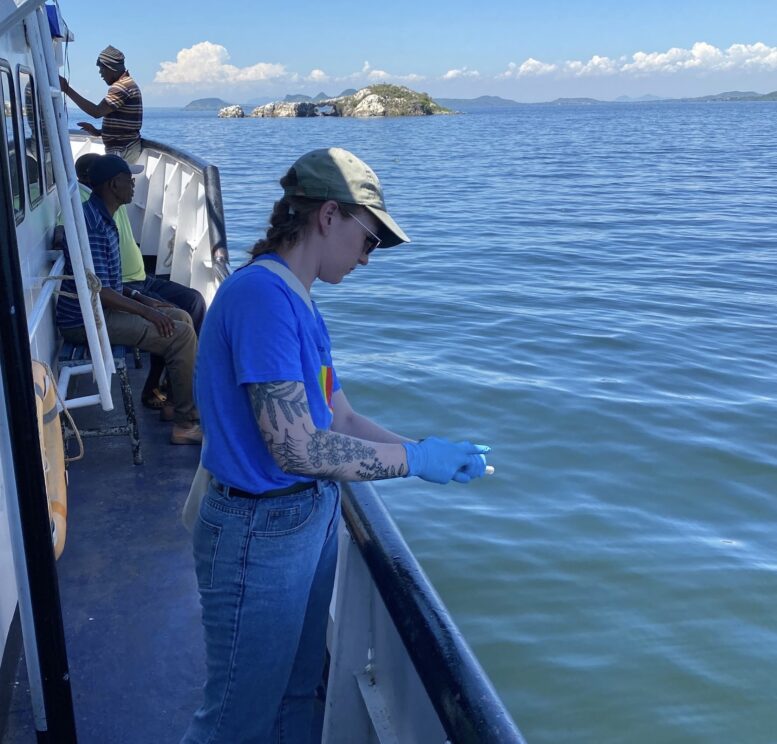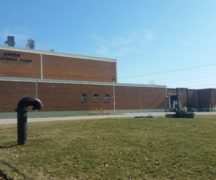From BGSU OFFICE OF MARKETING & BRAND STRATEGY
From Magee Marsh in Ohio to Stony Point, Michigan, a harmful algal bloom still lingers in Lake Erie’s waters, according to recent data from the National Oceanic and Atmospheric Administration.
This year, Bowling Green State University researchers have spent countless hours on Lake Erie studying the bloom to understand its impact on the health and well-being of the vital resource itself and on the people who rely upon it daily as a source for water, food, business and recreation.
In an effort to further understand the intricate issue, BGSU scientists have spent the last two years traveling to the Kenyan portion of Lake Victoria, which experiences similar blooms, to compare findings there and what they could mean for Lake Erie. Their most recent trip was this summer.

“The trips to Lake Victoria have been really beneficial for helping us better understand and potentially predict what lies ahead for Lake Erie when it comes to harmful algal blooms,” said Dr. George Bullerjahn, emeritus professor of Biological Sciences and the director of the Great Lakes Center for Fresh Waters and Human Health at BGSU.
Funded by a National Science Foundation grant of nearly $400,000, Bullerjahn and co-investigator Dr. Kefa Otiso from the School of Earth, Environment and Society have led the treks to Kenya, which include graduate students from multiple North American universities, including BGSU.
The scientists collaborate with researchers from the Kenya Marine and Fisheries Research Institute and Kisii University, with which BGSU formed a formal partnership in 2015 to promote joint research projects and to support faculty and student exchanges.
A harbinger of lake health
After collecting baseline samples in 2022, the researchers returned this year to Lake Victoria’s relatively calm and heavily populated gulf region to obtain new specimens to gather year-over-year data.
The team also focused its efforts on the understudied, open waters of Africa’s largest freshwater lake near the Ugandan border after observing prevalent toxic algae there versus in the gulf.
“The shift from the gulf to the lake’s open waters indicates that harmful algae is more widespread than perhaps initially thought,” Bullerjahn said. “Lake Victoria’s gulf is a source of water and food for nearly a million people, so it’s important to understand how algae impacts lives there. At the same time, it’s also important to know how toxic blooms affect the lake as a whole, so getting an understanding of the open waters is just as critical.”
In Lake Erie, a harmful algae byproduct known as microcystin is the main focus of water quality monitoring and testing. The U.S. EPA classifies it as a potent liver toxin and possible human carcinogen that can also kill livestock and pets. High levels of the toxin in the lake caused a multi-day shuttering of the city of Toledo’s water supply in 2014.
During both trips to Africa, the BGSU-led researchers discovered the presence of cylindrospermopsin, a toxin produced by harmful algae found in tropical freshwater bodies like Lake Victoria. The toxin was found to be more prevalent during this year’s trip. Although it has not been detected in Lake Erie, Bullerjahn said as climate patterns continue to change there is a real possibility the toxin could one day appear alongside microcystin.
“It’s critical that we gain an understanding now on how this toxin operates so that we know how to deal with it in the future,” Bullerjahn said. “We are looking at a very different Lake Erie compared to 30 or 40 years ago and Lake Victoria offers glimpses of what that future looks like for us here. The presence of cylindrospermopsin in a relatively-similar body of water gives us a sense that we need to expand our testing for toxins in Lake Erie so we can protect the public going forward.”
Student research efforts
When it comes to researching harmful algae, BGSU students are leading the comprehensive effort to analyze and make sense of bloom formation and how blooms function as a whole.
Reprising her role from the first trip, BGSU biology doctoral student Kate Brown returned to Africa with Bullerjahn this year to study the genetic makeup of toxic algae at various sites on Lake Victoria. In addition to monitoring for toxins, Brown sequenced and studied specific algal genes, which can help to determine how and why a bloom develops, grows or even shrinks.
“Much like genetics can determine one’s health, the same can be said for algae and the impact on the water it’s in,” Brown said. “If we have a better understanding of the genetic makeup of algae, we can have a better idea of what type of bloom could develop. If you’re only looking for one thing you might be missing the full picture, so having a full understanding of genetics means improved testing and detection for important bodies of water like Lake Erie.”
With an interest in pursuing similar work after graduation, Brown said BGSU has fostered comprehensive opportunities and invaluable connections that deepen her knowledge and passion for biology.
“Everyone at BGSU is incredibly supportive,” Brown said. “In addition to lab work on campus, the hands-on experience in the field has been great and working alongside and learning from those who live by Lake Victoria has been even better. I’ve made a lot of really great connections for collaboration going forward. BGSU, along with Dr. Bullerjahn, helped make it all possible.”
Working together to protect water
While researchers on the Bowling Green campus are studying algal blooms abroad, professors at BGSU Firelands in Huron, Ohio, are working to improve and sustain water quality along the Lake Erie coast.
BGSU Firelands was recently awarded a $35,000 grant from the Ohio Environmental Protection Agency to enhance environmental science education in high schools through watershed monitoring.
The grant will support a project in which Perkins High School, Huron High School and BGSU chemistry students at the Huron campus will monitor water quality in Sawmill Creek and Pipe Creek, two Lake Erie tributaries.
During the project, 100 Erie County high school students will participate in watershed monitoring programs with BGSU Firelands students serving as peer mentors.
An ongoing effort
With plans to return to Kenya again this winter, Bullerjahn said the University’s expansive and collaborative research in Africa is far from over as BGSU continues to advance the understanding of how harmful algae blooms affect lives at home and abroad.
“Water is life and it’s something we all need to survive, no matter where we live,” Bullerjahn said. “The more we can learn about harmful algal blooms, the more we can do to lessen their impact on the health and livelihoods of everyone who relies on freshwater sources, whether here in the United States or around the globe in Africa.”





